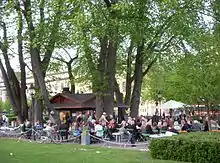Elm Conflict
The Elm Conflict (Swedish: Almstriden), also known as the Battle of the Elms (Swedish: Slaget om almarna), was a dispute and public protest on 11–12 May 1971. Organised by Alternativ stad (the Stockholm branch of Friends of the Earth), the dispute centred on the planned destruction of 13 Scots elm trees located at the entrance to the Kungsträdgården metro station in Kungsträdgården, Stockholm, Sweden. The Stockholm city council, supported by the Swedish government, proposed cutting down the trees to prevent damage to the nearby subway.
| Elm Conflict | |
|---|---|
| Date | 11–12 May 1971 |
| Location | |
| Methods | |
| Resulted in | Subway station moved east |

The Elm Conflict led to an examination of the need for citizens to have more input into the decision-making process of the city council, and received significant attention in Sweden's national media.[1]
Background
In 1970, subway construction workers found a crack in the subway structure in the vicinity of the Scots elms.[2] Officials decided that undertaking repairs would be too difficult, so they proposed cutting down the trees and placing the entrance to the new subway station at that location.[3] Stockholm parks manager Holger Blom noted that because of their age, the trees would not last much longer regardless.[4] Stockholm politicians and technicians tried to persuade the citizens via an advertising campaign that the trees needed to be removed. The city council voted 63 to 34 in favour of removing the trees.[4] On 23 April 1971, Prime Minister Olof Palme's government approved the final plans for the new subway station at Kungsträdgården.[2]
Protests
On 12 May, nearly 1,000 citizens of Stockholm gathered in a demonstration against the removal of the Scots elms. Protest tents were erected in the vicinity of the trees.[3]
The protests were well-organised. The protesters made phone lists (an early form of the smart mob technique of public mobilisation) in case the police entered the tent camps. Some people climbed the trees to deter workers from chopping them down.[2] The situation escalated when government officials started chainsawing the trees under the protection of police. At one point, officers on horseback charged the demonstrators. Singer Cornelis Vreeswijk was present at the protest, singing songs and offering support. The protests were covered extensively in the press.[5]
Aftermath

The protesters were criticised in the media for being uncivil and undemocratic. As a result of the protests, the entry to the new subway station was moved east to a private property at Arsenalgatan 10. Most of the Scots elms remain at the site as of 2014, though a few were chopped down by government officials before the protesters stopped further work.[3] The protests and the outcome are considered a turning point in the redevelopment of Norrmalm and have contributed to more attention being paid by the Swedish government to public demands and questions.[3]
A 40th anniversary commemoration of the Elm Conflict was held on 11 May 2011.[6]
References
- Abstract in English of Daniel Helldén, Demokratin utmanas: almstriden och det politiska etablissemanget Archived 9 December 2018 at the Wayback Machine. Stockholm studies in politics, Stockholm 2005. Retrieved 2 June 2014.
- "Tio år efter Almstriden" (in Swedish). SVT.se. Archived from the original on 31 May 2014. Retrieved 30 May 2014.
- "Tehuset och almarna. Striden satte djupa spår i svensk planering" (in Swedish). Sveriges Arkitekter. Archived from the original on 31 May 2014. Retrieved 30 May 2014.
- "Almstriden – en våldsam aktion och en folkfest" (in Swedish). Jordens Vänner. Archived from the original on 31 May 2014. Retrieved 30 May 2014.
- "Almarna 11 maj – Bakgrund" (in Swedish). Alternativstad.nu. Archived from the original on 7 September 2011. Retrieved 31 May 2014.
- "40 år sedan almstriden i Kungsträdgården" (in Swedish). Sveriges Radio. Archived from the original on 3 March 2016. Retrieved 21 June 2014.